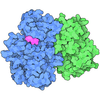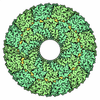| 登録情報 | データベース: PDB / ID: 1dev
|
|---|
| タイトル | CRYSTAL STRUCTURE OF SMAD2 MH2 DOMAIN BOUND TO THE SMAD-BINDING DOMAIN OF SARA |
|---|
 要素 要素 | - MAD (mothers against decapentaplegic, Drosophila) homolog 2
- Smad anchor for receptor activation
|
|---|
 キーワード キーワード | SIGNALING PROTEIN / BETA SHEET / THREE-HELIX BUNDLE |
|---|
| 機能・相同性 |  機能・相同性情報 機能・相同性情報
zygotic specification of dorsal/ventral axis / homomeric SMAD protein complex / activin responsive factor complex / paraxial mesoderm morphogenesis / SMAD4 MH2 Domain Mutants in Cancer / SMAD2/3 MH2 Domain Mutants in Cancer / nodal signaling pathway / SMAD protein complex / 1-phosphatidylinositol binding / endoderm formation ...zygotic specification of dorsal/ventral axis / homomeric SMAD protein complex / activin responsive factor complex / paraxial mesoderm morphogenesis / SMAD4 MH2 Domain Mutants in Cancer / SMAD2/3 MH2 Domain Mutants in Cancer / nodal signaling pathway / SMAD protein complex / 1-phosphatidylinositol binding / endoderm formation / heteromeric SMAD protein complex / pericardium development / co-SMAD binding / determination of left/right asymmetry in lateral mesoderm / FOXO-mediated transcription of cell cycle genes / regulation of transforming growth factor beta receptor signaling pathway / secondary palate development / trophoblast cell migration / odontoblast differentiation / SMAD2/3 Phosphorylation Motif Mutants in Cancer / TGFBR1 KD Mutants in Cancer / Transcriptional regulation of pluripotent stem cells / embryonic foregut morphogenesis / Germ layer formation at gastrulation / primary miRNA processing / transforming growth factor beta receptor binding / pulmonary valve morphogenesis / SMAD protein signal transduction / Formation of definitive endoderm / type I transforming growth factor beta receptor binding / Signaling by Activin / embryonic cranial skeleton morphogenesis / activin receptor signaling pathway / Formation of axial mesoderm / positive regulation of BMP signaling pathway / Signaling by NODAL / response to cholesterol / pancreas development / I-SMAD binding / negative regulation of ossification / aortic valve morphogenesis / anterior/posterior pattern specification / ureteric bud development / insulin secretion / endocardial cushion morphogenesis / endosomal transport / organ growth / SMAD binding / TGF-beta receptor signaling activates SMADs / R-SMAD binding / mesoderm formation / negative regulation of cell differentiation / anatomical structure morphogenesis / cell fate commitment / FOXO-mediated transcription of oxidative stress, metabolic and neuronal genes / response to glucose / phosphatase binding / positive regulation of epithelial to mesenchymal transition / cis-regulatory region sequence-specific DNA binding / gastrulation / transforming growth factor beta receptor signaling pathway / lung development / Downregulation of TGF-beta receptor signaling / post-embryonic development / Downregulation of SMAD2/3:SMAD4 transcriptional activity / SMAD2/SMAD3:SMAD4 heterotrimer regulates transcription / tau protein binding / endocytosis / disordered domain specific binding / double-stranded DNA binding / DNA-binding transcription activator activity, RNA polymerase II-specific / early endosome membrane / transcription regulator complex / DNA-binding transcription factor binding / in utero embryonic development / RNA polymerase II-specific DNA-binding transcription factor binding / DNA-binding transcription factor activity, RNA polymerase II-specific / cell differentiation / early endosome / cell population proliferation / Ub-specific processing proteases / intracellular signal transduction / RNA polymerase II cis-regulatory region sequence-specific DNA binding / DNA-binding transcription factor activity / protein domain specific binding / negative regulation of DNA-templated transcription / intracellular membrane-bounded organelle / DNA-templated transcription / ubiquitin protein ligase binding / chromatin binding / positive regulation of gene expression / regulation of DNA-templated transcription / chromatin / positive regulation of DNA-templated transcription / positive regulation of transcription by RNA polymerase II / protein-containing complex / zinc ion binding / nucleoplasm / metal ion binding / identical protein binding類似検索 - 分子機能 Smad Anchor For Receptor Activation; Chain B / Smad anchor for receptor activation, Smad-binding domain / Smad anchor for receptor activation, Smad-binding domain / Smad anchor for receptor activation, Smad-binding domain superfamily / Smad anchor for receptor activation (SARA) / Smad anchor for receptor activation (SARA) / Domain of unknown function DUF3480 / Zinc finger FYVE domain containing protein, SARA/endofin / Smad anchor for receptor activation-like, C-terminal / Domain of unknown function (DUF3480) ...Smad Anchor For Receptor Activation; Chain B / Smad anchor for receptor activation, Smad-binding domain / Smad anchor for receptor activation, Smad-binding domain / Smad anchor for receptor activation, Smad-binding domain superfamily / Smad anchor for receptor activation (SARA) / Smad anchor for receptor activation (SARA) / Domain of unknown function DUF3480 / Zinc finger FYVE domain containing protein, SARA/endofin / Smad anchor for receptor activation-like, C-terminal / Domain of unknown function (DUF3480) / Tumour Suppressor Smad4 - #10 / MAD homology, MH1 / Dwarfin / SMAD MH1 domain superfamily / MAD homology domain 1 (MH1) profile. / FYVE zinc finger / SMAD domain, Dwarfin-type / FYVE zinc finger / MH2 domain / MAD homology domain 2 (MH2) profile. / Protein present in Fab1, YOTB, Vac1, and EEA1 / Domain B in dwarfin family proteins / MAD homology 1, Dwarfin-type / MH1 domain / Domain A in dwarfin family proteins / Zinc finger, FYVE-related / Zinc finger FYVE/FYVE-related type profile. / SMAD-like domain superfamily / Tumour Suppressor Smad4 / SMAD/FHA domain superfamily / Zinc finger, FYVE/PHD-type / Few Secondary Structures / Irregular / Zinc finger, RING/FYVE/PHD-type / Sandwich / Mainly Beta類似検索 - ドメイン・相同性 Zinc finger FYVE domain-containing protein 9 / Mothers against decapentaplegic homolog 2類似検索 - 構成要素 |
|---|
| 生物種 |  Homo sapiens (ヒト) Homo sapiens (ヒト) |
|---|
| 手法 |  X線回折 / X線回折 /  シンクロトロン / 解像度: 2.2 Å シンクロトロン / 解像度: 2.2 Å |
|---|
 データ登録者 データ登録者 | Shi, Y. / Wu, G. |
|---|
 引用 引用 |  ジャーナル: Science / 年: 2000 ジャーナル: Science / 年: 2000
タイトル: Structural basis of Smad2 recognition by the Smad anchor for receptor activation.
著者: Wu, G. / Chen, Y.G. / Ozdamar, B. / Gyuricza, C.A. / Chong, P.A. / Wrana, J.L. / Massague, J. / Shi, Y. |
|---|
| 履歴 | | 登録 | 1999年11月15日 | 登録サイト: RCSB / 処理サイト: RCSB |
|---|
| 改定 1.0 | 2000年1月21日 | Provider: repository / タイプ: Initial release |
|---|
| 改定 1.1 | 2008年4月27日 | Group: Version format compliance |
|---|
| 改定 1.2 | 2011年7月13日 | Group: Version format compliance |
|---|
| 改定 1.3 | 2018年1月31日 | Group: Experimental preparation / カテゴリ: exptl_crystal_grow / Item: _exptl_crystal_grow.temp |
|---|
| 改定 1.4 | 2024年2月7日 | Group: Data collection / Database references / カテゴリ: chem_comp_atom / chem_comp_bond / database_2
Item: _database_2.pdbx_DOI / _database_2.pdbx_database_accession |
|---|
|
|---|
 データを開く
データを開く 基本情報
基本情報 要素
要素 キーワード
キーワード 機能・相同性情報
機能・相同性情報 Homo sapiens (ヒト)
Homo sapiens (ヒト) X線回折 /
X線回折 /  シンクロトロン / 解像度: 2.2 Å
シンクロトロン / 解像度: 2.2 Å  データ登録者
データ登録者 引用
引用 ジャーナル: Science / 年: 2000
ジャーナル: Science / 年: 2000 構造の表示
構造の表示 Molmil
Molmil Jmol/JSmol
Jmol/JSmol ダウンロードとリンク
ダウンロードとリンク ダウンロード
ダウンロード 1dev.cif.gz
1dev.cif.gz PDBx/mmCIF形式
PDBx/mmCIF形式 pdb1dev.ent.gz
pdb1dev.ent.gz PDB形式
PDB形式 1dev.json.gz
1dev.json.gz PDBx/mmJSON形式
PDBx/mmJSON形式 その他のダウンロード
その他のダウンロード 1dev_validation.pdf.gz
1dev_validation.pdf.gz wwPDB検証レポート
wwPDB検証レポート 1dev_full_validation.pdf.gz
1dev_full_validation.pdf.gz 1dev_validation.xml.gz
1dev_validation.xml.gz 1dev_validation.cif.gz
1dev_validation.cif.gz https://data.pdbj.org/pub/pdb/validation_reports/de/1dev
https://data.pdbj.org/pub/pdb/validation_reports/de/1dev ftp://data.pdbj.org/pub/pdb/validation_reports/de/1dev
ftp://data.pdbj.org/pub/pdb/validation_reports/de/1dev リンク
リンク 集合体
集合体
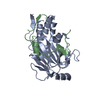
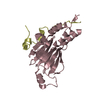
 要素
要素 Homo sapiens (ヒト) / 解説: THIS SEQUENCE OCCURS NATURALLY IN HUMANS / プラスミド: PET3 AND PGEX / 発現宿主:
Homo sapiens (ヒト) / 解説: THIS SEQUENCE OCCURS NATURALLY IN HUMANS / プラスミド: PET3 AND PGEX / 発現宿主: 
 Homo sapiens (ヒト) / 解説: THIS SEQUENCE OCCURS NATURALLY IN HUMANS / プラスミド: PET3 AND PGEX / 発現宿主:
Homo sapiens (ヒト) / 解説: THIS SEQUENCE OCCURS NATURALLY IN HUMANS / プラスミド: PET3 AND PGEX / 発現宿主: 
 X線回折 / 使用した結晶の数: 1
X線回折 / 使用した結晶の数: 1  試料調製
試料調製 シンクロトロン / サイト:
シンクロトロン / サイト:  NSLS
NSLS  / ビームライン: X25 / 波長: 1.15
/ ビームライン: X25 / 波長: 1.15  解析
解析 X-PLOR / バージョン: 3.851 / 分類: refinement
X-PLOR / バージョン: 3.851 / 分類: refinement ムービー
ムービー コントローラー
コントローラー





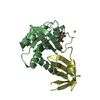
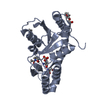

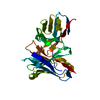
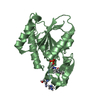

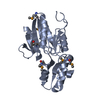

 PDBj
PDBj




